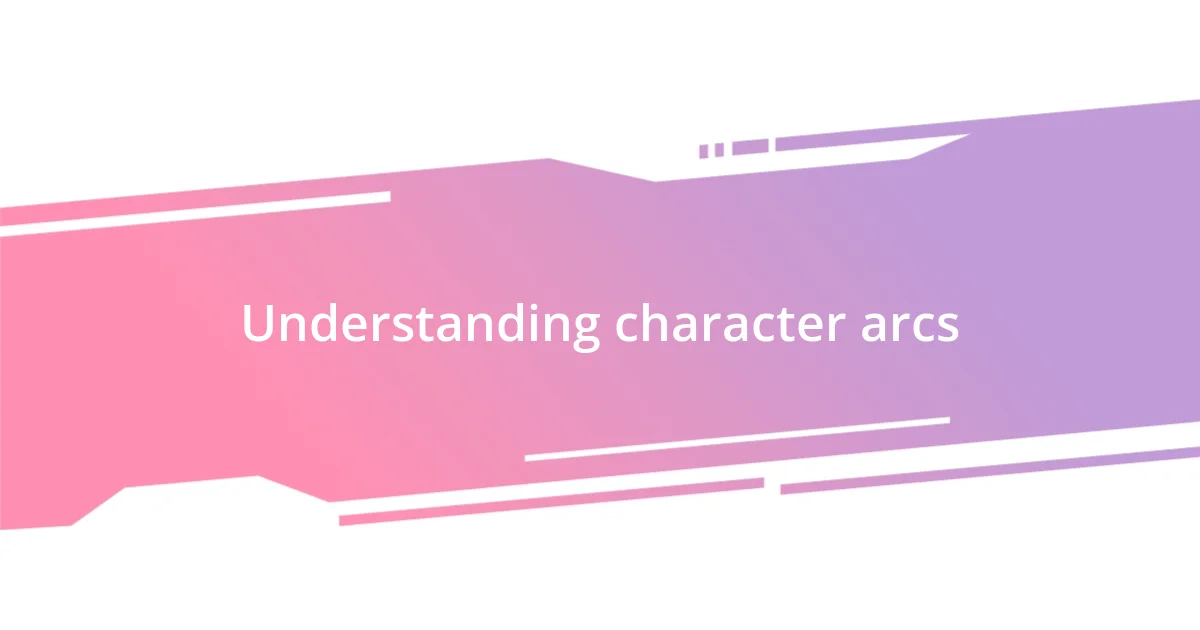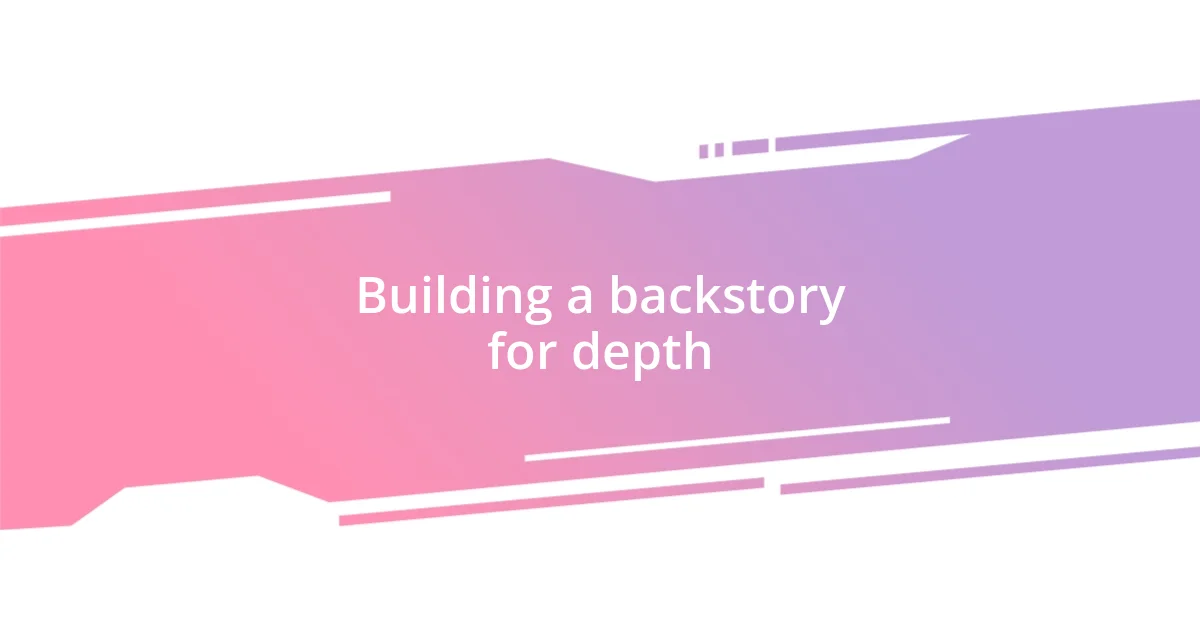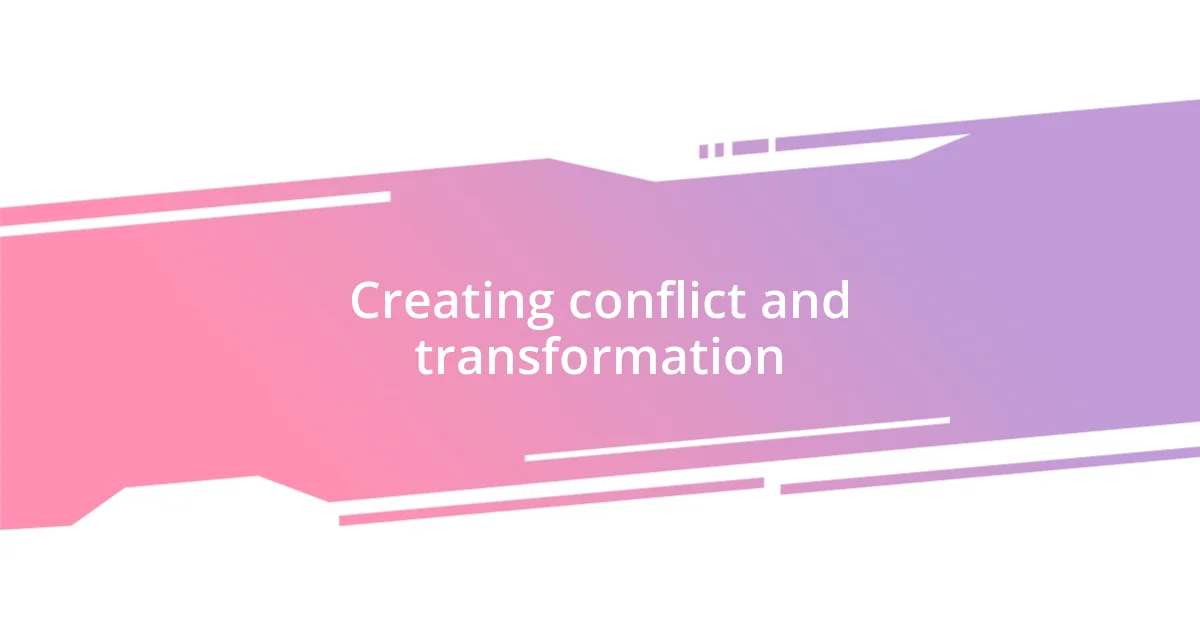Key takeaways:
- Character arcs illustrate emotional evolution, highlighting that change can be complex and nonlinear, often involving setbacks and personal growth.
- Building a backstory adds depth and realism to characters, as their past experiences influence their motivations, flaws, and relationships.
- Conflict is essential for transformation; internal and external struggles drive characters to confront their fears and ultimately evolve into more relatable and multidimensional figures.

Understanding character arcs
Character arcs are fascinating narratives that illustrate how characters evolve throughout a story. I remember the first time I truly recognized a character arc; it was during a gripping novel where the protagonist transformed from a self-doubtful introvert into a confident leader. It made me wonder: how does such change resonate with us?
In my experience, understanding character arcs means delving into their emotional landscapes. When I write, I often ask myself what experiences or relationships have shaped my characters’ motivations. For instance, I once created a character who faced betrayal, which sparked a journey of revenge and ultimately, redemption. This emotional rollercoaster not only made the character relatable but also provided a rich ground for growth.
It’s also essential to recognize that not all character arcs are linear. Some characters may regress or face setbacks, which can make their journeys feel more authentic. I recall a short story where a once-confident chef reverted to insecurity after a major failure. This struggle not only highlighted the fragility of human confidence but also emphasized the importance of resilience in personal growth. How do you think setbacks shape our understanding of character development?

Identifying complex character traits
Recognizing complex character traits involves observing not just their actions but also their motivations and conflicts. I once crafted a character who appeared arrogant on the surface, yet below that facade lay deep-seated fears of inadequacy. This dichotomy made me realize that the most compelling traits often exist in contradiction. How do conflicting traits affect your perception of characters?
It can be enlightening to analyze how characters respond to challenges. I created a protagonist who initially ran from their problems but gradually learned to face them head-on. This evolution showcased not only their growth but also the complexity of human emotion, revealing layers that readers can relate to. It’s fascinating how vulnerability can transform a seemingly simple trait into something profoundly complex.
When identifying these traits, consider the character’s backstory and relationships. For instance, a character shaped by a childhood of neglect may exhibit trust issues, influencing their dynamics with others. I’ve found that integrating personal history adds a rich texture to character analysis. Such depth makes characters memorable and relatable, as they often mirror aspects of our own journeys.
| Simple Traits | Complex Traits |
|---|---|
| Kindness | Kindness with ulterior motives |
| Confidence | Confidence interwoven with self-doubt |
| Resilience | Resilience masking deep pain |

Building a backstory for depth
Building a compelling backstory is essential for deepening character complexity. I remember crafting a character whose childhood trauma influenced every decision they made as an adult. That connection between past and present can prove invaluable; it provides context for their actions and relationships, making the reader sympathize with their journey. This background allows readers to see characters as multidimensional beings, not just caricatures.
- A character’s family dynamics can affect their worldview and reactions.
- Past failures often motivate their future choices, adding a layer of realism.
- The experiences that shaped them can create internal conflicts, driving meaningful development.
- Unique life experiences, such as travel or loss, contribute to one’s perspective and character depth.
In the stories I write, I often weave in these backstory elements as a way to enrich my characters’ arcs. For example, I created a character who grew up in a bustling city, sheltered from hardship. Her gradual exposure to the wider world lead her to question her values, transforming her from a naive dreamer into a discerning realist. The change was rooted in her backstory, making her evolution resonate more profoundly with readers.

Creating conflict and transformation
Creating conflict is essential to character transformation; it’s the catalyst for growth. In my experience, I once penned a character entrenched in a toxic relationship. As tensions escalated, the character was compelled to confront their own insecurities and long-held beliefs about love. This conflict not only drove the narrative forward but also forced them to reassess their values, leading to a significant transformation.
I often reflect on how internal and external conflicts can intertwine and create a richer narrative tapestry. For instance, I had a character who struggled with guilt from a past mistake. Every decision they made was influenced by this internal strife, but when faced with an external threat, they had to choose between self-preservation or redemption. This pivotal moment illustrated that true transformation often requires the convergence of inner turmoil and external pressures, pushing characters toward their most authentic selves.
A powerful moment in my writing journey came when I had to decide how far to take a character’s transformation. After grappling with a series of failures in the face of personal ambition, I put them in a situation where they had to let go of their lifelong dream to save someone they cared about. This decision not only marked their turning point but also posed a question I wrestled with: how do we measure success? The answer, I discovered, lies not in our achievements but in the choices we make when faced with real conflict.

Developing supporting characters
Developing supporting characters adds richness and contrast to your storytelling. I find that each supporting character should have their distinct motivations and flaws, which can create echoes or oppositions to the main character’s arc. For instance, I once created a sidekick who was fiercely loyal but harbored a hidden desire to break free from their mentor’s shadow. This internal struggle not only made their relationship dynamic but also highlighted the main character’s own fears of inadequacy. How often do we see ourselves mirrored in those around us?
It’s vital to remember that supporting characters shouldn’t just serve as plot devices; they should also evolve. I learned this when I wrote a story featuring a stern father figure who, through interactions with my main character, gradually revealed a softer side. This slow transformation transformed him from a mere obstacle into a compelling ally. Their dialogues took on a new depth as they both faced their pasts, resonating with themes of forgiveness and redemption. Isn’t it fascinating how our perceptions of others can shift as we learn their stories?
Furthermore, blending their arcs with the primary narrative can create a cohesive whole. I once intertwined a supporting character’s journey of self-discovery with the protagonist’s quest. They accidentally found common ground in their struggles, allowing readers to see the beauty of growth in different forms. By giving these characters space to breathe and evolve, we invite readers into a more immersive experience. Who hasn’t felt a connection with a minor character who unexpectedly steals the show?

Resolving character conflicts
My journey through character arcs has shown me that resolving character conflicts often requires a blend of courage and vulnerability. I remember crafting a scene where two characters, once best friends but now at odds, had to confront their differences. As they finally laid bare their fears and regrets, it was cathartic not just for them, but for me as the writer. I realized how powerful it is to allow characters to voice their pain; it’s a reminder that conflict resolution often hinges on open dialogue and the willingness to listen.
There was a time when I wrote a character who had a fierce rivalry with a sibling. The turning point came during a moment of crisis where they needed each other to overcome an external threat. As they fought side by side, something shifted. My writing process taught me that sometimes conflicts can dissolve when characters recognize shared goals, transforming animosity into alliance. Isn’t it fascinating how adversity can sometimes break down barriers that time and silence have built?
I also learned that emotional honesty is crucial in resolving conflicts. In one of my stories, a protagonist held grudges stemming from misunderstandings and unspoken words. The resolution came in an unexpected conversation that felt raw and real. As they expressed their feelings, I felt a wave of relief, almost as if I were releasing my own frustrations through these characters. It made me ponder: how often do we let pride or fear keep us from resolving our own conflicts? Through their journey, I was reminded that the heart of storytelling lies in our characters’ ability to confront and heal their divides.

Analyzing successful character arcs
Analyzing successful character arcs reveals common patterns that resonate deeply with audiences. For instance, I often reflect on a character I developed who seemed unassuming at first, yet the subtle revelations about her past created an intriguing depth. When she faced the ultimate challenge, her transformation from hesitant outsider to confident leader was not just rewarding for her but also for the readers who had been rooting for her growth. Isn’t it thrilling to watch a character evolve in ways we never expected?
Moreover, the interplay between a character’s internal conflicts and external circumstances can significantly enhance their arc. I recall crafting a story where a once-noble hero became disillusioned by betrayal, and his subsequent descent into cynicism felt achingly real. Yet, in the moments he grappled with his choice to either sink deeper into bitterness or rise again, it mirrored struggles many of us face. Have you ever found yourself standing at a crossroads, wondering which path to choose?
The best arcs not only allow for transformation but also invite readers to share in that journey of self-discovery. I remember writing a character who initially thrived on chaos, yet through a series of humbling experiences, began to understand the value of stability in life. As I penned her gradual change, I often asked myself: what does it really mean to find peace within oneself? Such questions deepen the narrative, making both the character and reader reflect on the essence of personal growth. It’s intriguing how a well-crafted arc can echo our own life experiences, making the story feel intimately connected to us.














